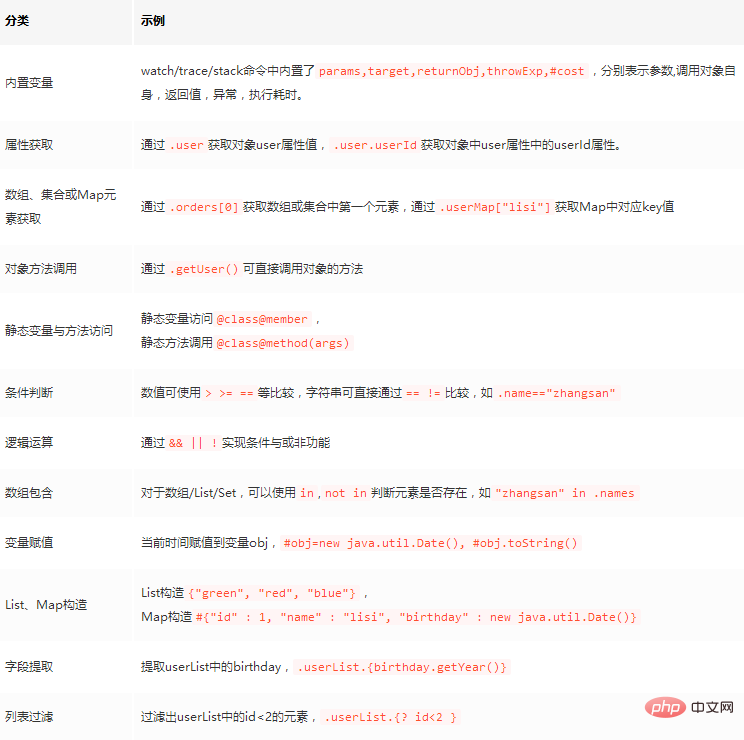Home >Operation and Maintenance >Linux Operation and Maintenance >Dynamic tracking tool for Linux command collection (detailed examples)
This article brings you knowledge about Linux command dynamic tracing tools, including strace, arthas, bpftrace, etc., which are commonly used dynamic tracing tools in work. I hope everyone has to help.

Thread and memory analysis can only observe the overall situation of the process. Sometimes we need to observe a certain method level, such as when calling the method test(), pass in What are the parameters, what is the return value, and how much time does it take? In this case, we need to use some dynamic tracing tools, such as strace, arthas, bpftrace, systemtap, etc.
strace and ltrace
strace is a tool used to observe system calls in Linux. Anyone who has studied the principles of the operating system knows that the operating system is The application exposes a number of system call interfaces, and the application can only access the operating system through these system call interfaces, such as applying for memory, files, or network IO operations.
Usage is as follows:
# -T 打印系统调用花费的时间 # -tt 打印系统调用的时间点 # -s 输出的最大长度,默认32,对于调用参数较长的场景,建议加大 # -f 是否追踪fork出来子进程的系统调用,由于服务端服务普通使用线程池,建议加上 # -p 指定追踪的进程pid # -o 指定追踪日志输出到哪个文件,不指定则直接输出到终端 $ strace -T -tt -f -s 10000 -p 87 -o strace.log
Instance: Capture the actual sent SQL
Sometimes, we will find that in the code There is absolutely no problem with the SQL, but no data can be found. This is most likely because some underlying frameworks in the project have rewritten the SQL, causing the actual SQL sent to be different from the SQL in the code.
When encountering this situation, don't rush to dig out the underlying framework code. It will take more time. After all, programmers' time is precious, otherwise they will have to work overtime. How can you quickly confirm whether this is the reason? Woolen cloth?
There are two methods. The first is to use wireshark to capture packets, and the second is strace introduced in this article. Since the program must send SQL commands to the database through network io-related system calls, Therefore, we only need to use strace to track all system calls, and then grep out the system calls that send SQL, as follows:
$ strace -T -tt -f -s 10000 -p 87 |& tee strace.log

As can be clearly seen from the picture, mysql The jdbc driver sends SQL through the sendto system call, and obtains the return result through recvfrom. It can be found that since SQL is a string, strace automatically helps us identify it, and the return result is not easy to identify because it is binary. It is necessary Only if you are very familiar with the mysql protocol.
In addition, it is easy to see from the above that SQL execution takes time. Just calculate the time difference between sendto and recvfrom with the same thread number.
ltrace
Since most processes basically use the basic c library instead of system calls, such as glibc on Linux, glibc on Windows, msvc, so there is also a tool ltrace, which can be used to track library calls, as follows:
$ ltrace -T -tt -f -s 10000 -p 87 -o ltrace.log
The basic usage is the same as strace. Generally speaking, using strace is enough.
arthas
arthas is a dynamic tracking tool under java. It can observe the calling parameters, return values, etc. of java methods, except In addition, it also provides many practical functions, such as decompilation, thread profiling, heap memory dump, flame graph, etc.
Download and use
# 下载arthas $ wget https://arthas.aliyun.com/download/3.4.6?mirror=aliyun -O arthas-packaging-3.4.6-bin.zip # 解压 $ unzip arthas-packaging-3.4.6-bin.zip -d arthas && cd arthas/ # 进入arthas命令交互界面 $ java -jar arthas-boot.jar `pgrep -n java` [INFO] arthas-boot version: 3.4.6 [INFO] arthas home: /home/work/arthas [INFO] Try to attach process 3368243 [INFO] Attach process 3368243 success. [INFO] arthas-client connect 127.0.0.1 3658 ,---. ,------. ,--------.,--. ,--. ,---. ,---. / O \ | .--. ''--. .--'| '--' | / O \ ' .-' | .-. || '--'.' | | | .--. || .-. |`. `-. | | | || |\ \ | | | | | || | | |.-' | `--' `--'`--' '--' `--' `--' `--'`--' `--'`-----' wiki https://arthas.aliyun.com/doc tutorials https://arthas.aliyun.com/doc/arthas-tutorials.html version 3.4.6 pid 3368243 time 2021-11-13 13:35:49 # help可查看arthas提供了哪些命令 [arthas@3368243]$ help # help watch可查看watch命令具体用法 [arthas@3368243]$ help watch
watch, trace and stack
In arthas, use The watch, trace, and stack commands can observe the method invocation, as follows:
# watch观测执行的查询SQL,-x 3指定对象展开层级
[arthas@3368243]$ watch org.apache.ibatis.executor.statement.PreparedStatementHandler parameterize '{target.boundSql.sql,target.boundSql.parameterObject}' -x 3
method=org.apache.ibatis.executor.statement.PreparedStatementHandler.parameterize location=AtExit
ts=2021-11-13 14:50:34; [cost=0.071342ms] result=@ArrayList[
@String[select id,log_info,create_time,update_time,add_time from app_log where id=?],
@ParamMap[
@String[id]:@Long[41115],
@String[param1]:@Long[41115],
],
]
# watch观测耗时超过200ms的SQL
[arthas@3368243]$ watch com.mysql.jdbc.PreparedStatement execute '{target.toString()}' 'target.originalSql.contains("select") && #cost > 200' -x 2
Press Q or Ctrl+C to abort.
Affect(class count: 3 , method count: 1) cost in 123 ms, listenerId: 25
method=com.mysql.jdbc.PreparedStatement.execute location=AtExit
ts=2021-11-13 14:58:42; [cost=1001.558851ms] result=@ArrayList[
@String[com.mysql.jdbc.PreparedStatement@6283cfe6: select count(*) from app_log],
]
# trace追踪方法耗时,层层追踪,就可找到耗时根因,--skipJDKMethod false显示jdk方法耗时,默认不显示
[arthas@3368243]$ trace com.mysql.jdbc.PreparedStatement execute 'target.originalSql.contains("select") && #cost > 200' --skipJDKMethod false
Press Q or Ctrl+C to abort.
Affect(class count: 3 , method count: 1) cost in 191 ms, listenerId: 26
---ts=2021-11-13 15:00:40;thread_name=http-nio-8080-exec-47;id=76;is_daemon=true;priority=5;TCCL=org.springframework.boot.web.embedded.tomcat.TomcatEmbeddedWebappClassLoader@5a2d131d
---[1001.465544ms] com.mysql.jdbc.PreparedStatement:execute()
+---[0.022119ms] com.mysql.jdbc.PreparedStatement:checkClosed() #1274
+---[0.016294ms] com.mysql.jdbc.MySQLConnection:getConnectionMutex() #57
+---[0.017862ms] com.mysql.jdbc.PreparedStatement:checkReadOnlySafeStatement() #1278
+---[0.008996ms] com.mysql.jdbc.PreparedStatement:createStreamingResultSet() #1294
+---[0.010783ms] com.mysql.jdbc.PreparedStatement:clearWarnings() #1296
+---[0.017843ms] com.mysql.jdbc.PreparedStatement:fillSendPacket() #1316
+---[0.008543ms] com.mysql.jdbc.MySQLConnection:getCatalog() #1320
+---[0.009293ms] java.lang.String:equals() #57
+---[0.008824ms] com.mysql.jdbc.MySQLConnection:getCacheResultSetMetadata() #1328
+---[0.009892ms] com.mysql.jdbc.MySQLConnection:useMaxRows() #1354
+---[1001.055229ms] com.mysql.jdbc.PreparedStatement:executeInternal() #1379
+---[0.02076ms] com.mysql.jdbc.ResultSetInternalMethods:reallyResult() #1388
+---[0.011517ms] com.mysql.jdbc.MySQLConnection:getCacheResultSetMetadata() #57
+---[0.00842ms] com.mysql.jdbc.ResultSetInternalMethods:getUpdateID() #1404
---[0.008112ms] com.mysql.jdbc.ResultSetInternalMethods:reallyResult() #1409
# stack追踪方法调用栈,找到耗时SQL来源
[arthas@3368243]$ stack com.mysql.jdbc.PreparedStatement execute 'target.originalSql.contains("select") && #cost > 200'
Press Q or Ctrl+C to abort.
Affect(class count: 3 , method count: 1) cost in 138 ms, listenerId: 27
ts=2021-11-13 15:01:55;thread_name=http-nio-8080-exec-5;id=2d;is_daemon=true;priority=5;TCCL=org.springframework.boot.web.embedded.tomcat.TomcatEmbeddedWebappClassLoader@5a2d131d
@com.mysql.jdbc.PreparedStatement.execute()
at com.alibaba.druid.pool.DruidPooledPreparedStatement.execute(DruidPooledPreparedStatement.java:493)
at org.apache.ibatis.executor.statement.PreparedStatementHandler.query(PreparedStatementHandler.java:63)
at org.apache.ibatis.executor.statement.RoutingStatementHandler.query(RoutingStatementHandler.java:79)
at org.apache.ibatis.executor.SimpleExecutor.doQuery(SimpleExecutor.java:63)
at org.apache.ibatis.executor.BaseExecutor.queryFromDatabase(BaseExecutor.java:326)
at org.apache.ibatis.executor.BaseExecutor.query(BaseExecutor.java:156)
at org.apache.ibatis.executor.BaseExecutor.query(BaseExecutor.java:136)
at org.apache.ibatis.session.defaults.DefaultSqlSession.selectList(DefaultSqlSession.java:148)
at org.apache.ibatis.session.defaults.DefaultSqlSession.selectList(DefaultSqlSession.java:141)
at org.apache.ibatis.session.defaults.DefaultSqlSession.selectOne(DefaultSqlSession.java:77)
at sun.reflect.GeneratedMethodAccessor75.invoke(null:-1)
at sun.reflect.DelegatingMethodAccessorImpl.invoke(DelegatingMethodAccessorImpl.java:43)
at java.lang.reflect.Method.invoke(Method.java:498)
at org.mybatis.spring.SqlSessionTemplate$SqlSessionInterceptor.invoke(SqlSessionTemplate.java:433)
at com.sun.proxy.$Proxy113.selectOne(null:-1)
at org.mybatis.spring.SqlSessionTemplate.selectOne(SqlSessionTemplate.java:166)
at org.apache.ibatis.binding.MapperMethod.execute(MapperMethod.java:83)
at org.apache.ibatis.binding.MapperProxy.invoke(MapperProxy.java:59)
at com.sun.proxy.$Proxy119.selectCost(null:-1)
at com.demo.example.web.controller.TestController.select(TestController.java:57)You can see that conditional expressions can be specified in the watch, trace, and stack commands, as long as the ognl expression syntax is met, ognl complete syntax It's very complicated. Here are some commonly used ones:

##ognl
Through the ognl command, you can directly View the value of the static variable, as follows:# 调用System.getProperty静态函数,查看jvm默认字符编码
[arthas@3368243]$ ognl '@System@getProperty("file.encoding")'
@String[UTF-8]
# 找到springboot类加载器
[arthas@3368243]$ classloader -t
+-BootstrapClassLoader
+-sun.misc.Launcher$ExtClassLoader@492691d7
+-sun.misc.Launcher$AppClassLoader@764c12b6
+-org.springframework.boot.loader.LaunchedURLClassLoader@4361bd48
# 获取springboot中所有的beanName,-c指定springboot的classloader的hash值
# 一般Spring项目,都会定义一个SpringUtil的,用于获取bean容器ApplicationContext
[arthas@3368243]$ ognl -c 4361bd48 '#context=@com.demo.example.web.SpringUtil@applicationContext, #context.beanFactory.beanDefinitionNames'
@String[][
@String[org.springframework.context.annotation.internalConfigurationAnnotationProcessor],
@String[org.springframework.context.annotation.internalAutowiredAnnotationProcessor],
@String[org.springframework.context.annotation.internalCommonAnnotationProcessor],
@String[testController],
@String[apiController],
@String[loginService],
...
]
# 获取springboot配置,如server.port是配置http服务端口的
[arthas@3368243]$ ognl -c 4361bd48 '#context=@com.demo.example.web.SpringUtil@applicationContext, #context.getEnvironment().getProperty("server.port")'
@String[8080]
# 查看server.port定义在哪个配置文件中
# 可以很容易看到,server.port定义在application-web.yml
[arthas@3368243]$ ognl -c 4361bd48 '#context=@com.demo.example.web.SpringUtil@applicationContext, #context.environment.propertySources.propertySourceList.{? containsProperty("server.port")}'
@ArrayList[
@ConfigurationPropertySourcesPropertySource[ConfigurationPropertySourcesPropertySource {name='configurationProperties'}],
@OriginTrackedMapPropertySource[OriginTrackedMapPropertySource {name='applicationConfig: [classpath:/application-web.yml]'}],
]
# 调用springboot中bean的方法,获取返回值
[arthas@3368243]$ ognl -c 4361bd48 '#context=@com.demo.example.web.SpringUtil@applicationContext, #context.getBean("demoMapper").queryOne(12)' -x 2
@ArrayList[
@HashMap[
@String[update_time]:@Timestamp[2021-11-09 18:38:13,000],
@String[create_time]:@Timestamp[2021-04-17 15:52:55,000],
@String[log_info]:@String[TbTRNsh2SixuFrkYLTeb25a6zklEZj0uWANKRMe],
@String[id]:@Long[12],
@String[add_time]:@Integer[61],
],
]
# 查看springboot自带tomcat的线程池的情况
[arthas@3368243]$ ognl -c 4361bd48 '#context=@com.demo.example.web.SpringUtil@applicationContext, #context.webServer.tomcat.server.services[0].connectors[0].protocolHandler.endpoint.executor'
@ThreadPoolExecutor[
sm=@StringManager[org.apache.tomcat.util.res.StringManager@16886f49],
submittedCount=@AtomicInteger[1],
threadRenewalDelay=@Long[1000],
workQueue=@TaskQueue[isEmpty=true;size=0],
mainLock=@ReentrantLock[java.util.concurrent.locks.ReentrantLock@69e9cf90[Unlocked]],
workers=@HashSet[isEmpty=false;size=10],
largestPoolSize=@Integer[49],
completedTaskCount=@Long[10176],
threadFactory=@TaskThreadFactory[org.apache.tomcat.util.threads.TaskThreadFactory@63c03c4f],
handler=@RejectHandler[org.apache.tomcat.util.threads.ThreadPoolExecutor$RejectHandler@3667e559],
keepAliveTime=@Long[60000000000],
allowCoreThreadTimeOut=@Boolean[false],
corePoolSize=@Integer[10],
maximumPoolSize=@Integer[8000],
]
Other commands
arthas also provides jvm disk, thread analysis, heap dump, reverse Compilation, flame graph and other functions are as follows:# 显示耗cpu较多的前4个线程
[arthas@3368243]$ thread -n 4
"C2 CompilerThread0" [Internal] cpuUsage=8.13% deltaTime=16ms time=46159ms
"C2 CompilerThread1" [Internal] cpuUsage=4.2% deltaTime=8ms time=47311ms
"C1 CompilerThread2" [Internal] cpuUsage=3.06% deltaTime=6ms time=17402ms
"http-nio-8080-exec-40" Id=111 cpuUsage=1.29% deltaTime=2ms time=624ms RUNNABLE (in native)
at java.net.SocketInputStream.socketRead0(Native Method)
...
at com.mysql.jdbc.MysqlIO.checkErrorPacket(MysqlIO.java:4113)
at com.mysql.jdbc.MysqlIO.sendCommand(MysqlIO.java:2570)
at com.mysql.jdbc.MysqlIO.sqlQueryDirect(MysqlIO.java:2731)
at com.mysql.jdbc.ConnectionImpl.execSQL(ConnectionImpl.java:2818)
...
at com.demo.example.web.controller.TestController.select(TestController.java:57)
# 堆转储
[arthas@3368243]$ heapdump
Dumping heap to /tmp/heapdump2021-11-13-15-117226383240040009563.hprof ...
Heap dump file created
# cpu火焰图,容器环境下profiler start可能用不了,可用profiler start -e itimer替代
[arthas@3368243]$ profiler start
Started [cpu] profiling
[arthas@3368243]$ profiler stop
OK
profiler output file: /home/work/app/arthas-output/20211113-151208.svg
# dashboard就类似Linux下的top一样,可看jvm线程、堆内存的整体情况
[arthas@3368243]$ dashboard
# jvm就类似Linux下的ps一样,可以看jvm进程的一些基本信息,如:jvm参数、类加载、线程数、打开文件描述符数等
[arthas@3368243]$ jvm
# 反编译
[arthas@3368243]$ jad com.demo.example.web.controller.TestController It can be seen that arthas is no longer a simple dynamic tracking tool. It includes almost all diagnostic functions commonly used under jvm.
bpftrace
arthas can only track java programs and cannot do anything about native programs (such as MySQL). Fortunately, the Linux ecosystem provides a large number of The mechanism and supporting tools can be used to track the calls of native programs, such as perf, bpftrace, systemtap, etc. Since bpftrace is relatively difficult to use, this article mainly introduces its usage. bpftrace is a dynamic tracking tool based on ebpf technology. It encapsulates ebpf technology and implements a scripting language. Just like arthas introduced above is based on ognl, the scripting language it implements is similar to awk. Encapsulates common statement blocks and provides built-in variables and built-in functions, as follows:$ sudo bpftrace -e 'BEGIN { printf("Hello, World!\n"); } '
Attaching 1 probe...
Hello, World!
Example: Tracking slow SQL on the calling side
前面我们用strace追踪过mysql的jdbc驱动,它使用sendto与recvfrom系统调用来与mysql服务器通信,因此,我们在sendto调用时,计下时间点,然后在recvfrom结束时,计算时间之差,就可以得到相应SQL的耗时了,如下:
先找到sendto与recvfrom系统调用在bpftrace中的追踪点,如下:
# 查找sendto|recvfrom系统调用的追踪点,可以看到sys_enter_开头的追踪点应该是进入时触发,sys_exit_开头的退出时触发
$ sudo bpftrace -l '*tracepoint:syscalls*' |grep -E 'sendto|recvfrom'
tracepoint:syscalls:sys_enter_sendto
tracepoint:syscalls:sys_exit_sendto
tracepoint:syscalls:sys_enter_recvfrom
tracepoint:syscalls:sys_exit_recvfrom
# 查看系统调用参数,方便我们编写脚本
$ sudo bpftrace -lv tracepoint:syscalls:sys_enter_sendto
tracepoint:syscalls:sys_enter_sendto
int __syscall_nr;
int fd;
void * buff;
size_t len;
unsigned int flags;
struct sockaddr * addr;
int addr_len;编写追踪脚本trace_slowsql_from_syscall.bt,脚本代码如下:
#!/usr/local/bin/bpftrace
BEGIN {
printf("Tracing jdbc SQL slower than %d ms by sendto/recvfrom syscall\n", $1);
printf("%-10s %-6s %6s %s\n", "TIME(ms)", "PID", "MS", "QUERY");
}
tracepoint:syscalls:sys_enter_sendto /comm == "java"/ {
// mysql协议中,包开始的第5字节指示命令类型,3代表SQL查询
$com = *(((uint8 *) args->buff)+4);
if($com == (uint8)3){
@query[tid]=str(((uint8 *) args->buff)+5, (args->len)-5);
@start[tid]=nsecs;
}
}
tracepoint:syscalls:sys_exit_recvfrom /comm == "java" && @start[tid]/ {
$dur = (nsecs - @start[tid]) / 1000000;
if ($dur > $1) {
printf("%-10u %-6d %6d %s\n", elapsed / 1000000, pid, $dur, @query[tid]);
}
delete(@query[tid]);
delete(@start[tid]);
}其中,comm表示进程名称,tid表示线程号,@query[tid]与@start[tid]类似map,以tid为key的话,这个变量就像一个线程本地变量了。
调用上面的脚本,可以看到各SQL执行耗时,如下:
$ sudo BPFTRACE_STRLEN=80 bpftrace trace_slowsql_from_syscall.bt Attaching 3 probes... Tracing jdbc SQL slower than 0 ms by sendto/recvfrom syscall TIME(ms) PID MS QUERY 6398 3368243 125 select sleep(0.1) 16427 3368243 22 select id from app_log al order by id desc limit 1 16431 3368243 20 select id,log_info,create_time,update_time,add_time from app_log where id=11692 17492 3368243 21 select id,log_info,create_time,update_time,add_time from app_log where id=29214
实例:在服务端追踪慢SQL
从调用端来追踪SQL耗时,会包含网络往返时间,为了得到更精确的SQL耗时,我们可以写一个追踪服务端mysql的脚本,来观测SQL耗时,如下:
确定mysqld服务进程的可执行文件与入口函数
$ which mysqld /usr/local/mysql/bin/mysqld # objdump可导出可执行文件的动态符号表,做几张mysqld的火焰图就可发现,dispatch_command是SQL处理的入口函数 # 另外,由于mysql是c++写的,方法名是编译器改写过的,这也是为啥下面脚本中要用*dispatch_command*模糊匹配 $ objdump -tT /usr/local/mysql/bin/mysqld | grep dispatch_command 00000000014efdf3 g F .text 000000000000252e _Z16dispatch_commandP3THDPK8COM_DATA19enum_server_command 00000000014efdf3 g DF .text 000000000000252e Base _Z16dispatch_commandP3THDPK8COM_DATA19enum_server_command
使用uprobe追踪dispatch_command的调用,如下:
#!/usr/bin/bpftrace
BEGIN{
printf("Tracing mysqld SQL slower than %d ms. Ctrl-C to end.\n", $1);
printf("%-10s %-6s %6s %s\n", "TIME(ms)", "PID", "MS", "QUERY");
}
uprobe:/usr/local/mysql/bin/mysqld:*dispatch_command*{
if (arg2 == (uint8)3) {
@query[tid] = str(*arg1);
@start[tid] = nsecs;
}
}
uretprobe:/usr/local/mysql/bin/mysqld:*dispatch_command* /@start[tid]/{
$dur = (nsecs - @start[tid]) / 1000000;
if ($dur > $1) {
printf("%-10u %-6d %6d %s\n", elapsed / 1000000, pid, $dur, @query[tid]);
}
delete(@query[tid]);
delete(@start[tid]);
}追踪脚本整体上与之前系统调用版本的类似,不过追踪点不一样而已。
实例:找出扫描大量行的SQL
众所周知,SQL执行时需要扫描数据,并且扫描的数据越多,SQL性能就会越差。
但对于一些中间情况,SQL扫描行数不多也不少,如2w条。且这2w条数据都在缓存中的话,SQL执行时间不会很长,导致没有记录在慢查询日志中,但如果这样的SQL并发量大起来的话,会非常耗费CPU。
对于mysql的话,扫描行的函数是row_search_mvcc(如果你经常抓取mysql栈的话,很容易发现这个函数),每扫一行调用一次,如果在追踪脚本中追踪此函数,记录下调用次数,就可以观测SQL的扫描行数了,如下:
#!/usr/bin/bpftrace
BEGIN{
printf("Tracing mysqld SQL scan row than %d. Ctrl-C to end.\n", $1);
printf("%-10s %-6s %6s %10s %s\n", "TIME(ms)", "PID", "MS", "SCAN_NUM", "QUERY");
}
uprobe:/usr/local/mysql/bin/mysqld:*dispatch_command*{
$COM_QUERY = (uint8)3;
if (arg2 == $COM_QUERY) {
@query[tid] = str(*arg1);
@start[tid] = nsecs;
}
}
uprobe:/usr/local/mysql/bin/mysqld:*row_search_mvcc*{
@scan_num[tid]++;
}
uretprobe:/usr/local/mysql/bin/mysqld:*dispatch_command* /@start[tid]/{
$dur = (nsecs - @start[tid]) / 1000000;
if (@scan_num[tid] > $1) {
printf("%-10u %-6d %6d %10d %s\n", elapsed / 1000000, pid, $dur, @scan_num[tid], @query[tid]);
}
delete(@query[tid]);
delete(@start[tid]);
delete(@scan_num[tid]);
}脚本运行效果如下:
$ sudo BPFTRACE_STRLEN=80 bpftrace trace_mysql_scan.bt 200
Attaching 4 probes...
Tracing mysqld SQL scan row than 200. Ctrl-C to end.
TIME(ms) PID MS SCAN_NUM QUERY
150614 1892 4 300 select * from app_log limit 300
# 全表扫描,慢!
17489 1892 424 43717 select count(*) from app_log
# 大范围索引扫描,慢!
193013 1892 253 20000 select count(*) from app_log where id < 20000
# 深分页,会查询前20300条,取最后300条,慢!
213395 1892 209 20300 select * from app_log limit 20000,300
# 索引效果不佳,虽然只会查到一条数据,但扫描数据量不会少,慢!
430374 1892 186 15000 select * from app_log where id < 20000 and seq = 15000 limit 1如上所示,app_log是我建的一张测试表,共43716条数据,其中id字段是自增主键,seq值与id值一样,但没有索引。
可以看到上面的几个场景,不管什么场景,只要扫描行数变大,耗时就会变长,但也都没有超过500毫秒的,原因是这个表很小,数据可以全部缓存在内存中。
可见,像bpftrace这样的动态追踪工具是非常强大的,而且比arthas更加灵活,arthas只能追踪单个函数,而bpftrace可以跨函数追踪。
总结
已经介绍了不少诊断工具了,这里简单概括一下它们的应用场景:
软件资源观测,如ps、lsof、netstat,用来检查进程基本情况,如内存占用、打开哪些文件、创建了哪些连接等。
硬件资源观测,如top、iostat、sar等,类似Windows上任务管理器一样,让你对硬件资源占用以及在进程上情况有个大概了解,最多观测到线程级别,这些工具一般只能指示进一步调查的方向,很少能直接确认原因。
线程与内存剖析,如jstack、jmap等,比较容易分析线程卡住或内存oom问题,而oncpu火焰图容易找出热代码路径,分析高cpu瓶颈,offcpu火焰图则容易找出经常阻塞的代码路径,分析高耗时问题。
动态追踪工具,如arthas、bpftrace等,能追踪到方法调用级,常用于问题需要深入调查的场景,如问题不在代码实现上,而在调用数据上,就像上面row_search_mvcc函数一样,抓火焰图会发现它出现频繁,但由于它是核心函数,这个频繁可能是正常的,也可能是不正常的,需要将调用次数分散到SQL上才能确认。
相关推荐:《Linux视频教程》
The above is the detailed content of Dynamic tracking tool for Linux command collection (detailed examples). For more information, please follow other related articles on the PHP Chinese website!